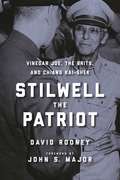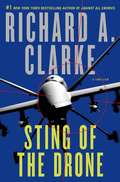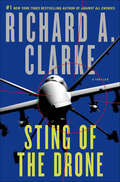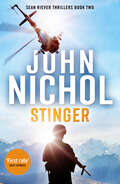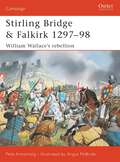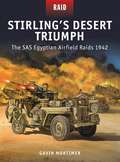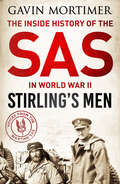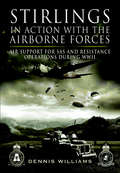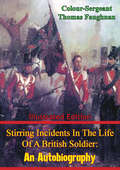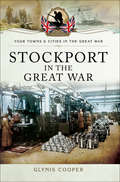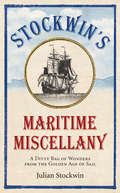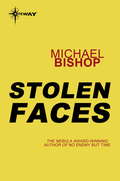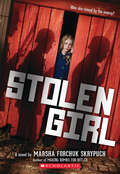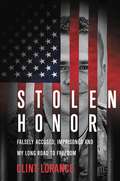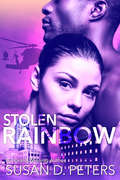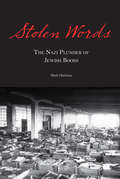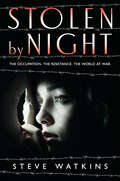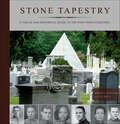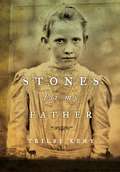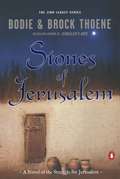- Table View
- List View
Stilwell the Patriot: Vinegar Joe, the Brits, and Chiang Kai-Shek
by John S. Major David RooneyJoe Stilwell, known as "Vinegar Joe” for his caustic personality, was stationed in Burma during World War II and famously differed in strategy from other commanders in his division. In retrospect analyses, it’s said that if he had gotten his way, the United States might have defeated the Communists in 1945 and changed the course of history. This meticulously-reached biography of Vinegar Joe presents an intimate account of his career, working as Chinese military leader Chiang Kai-shek’s chief of staff, the commander of the Chinese divisions in Burma, and the deputy supreme commander of the South East Asia Command. It explores Stilwell’s determination to drive a road through the jungle in order to reopen the old Burma Road, and his passion to ensure that the colossal American contribution to the Burma Campaign was not misappropriated by Chiang, his boss. In recounting Vinegar Joe’s unusual escapades, historian David Rooney provides an intimate understanding of why Stilwell came to distrust and despise Chiang, and why he was fiercely critical of his fellow commanders. Simultaneously sympathetic and critical, the biography is one of a controversial American patriot. And in addition to Rooney’s compelling and enlightening text, Stilwell the Patriot features fifteen black-and-white photographs and six maps. The images includes photographs of Stilwell and Chiang, American tanks in Burma, and maps of where nearby battles took place. After a limited print-run more than ten years ago, Stilwell the Patriot is being put back in print shortly after the seventieth anniversary of the Burma Campaign. Skyhorse Publishing, along with our Arcade, Good Books, Sports Publishing, and Yucca imprints, is proud to publish a broad range of biographies, autobiographies, and memoirs. Our list includes biographies on well-known historical figures like Benjamin Franklin, Nelson Mandela, and Alexander Graham Bell, as well as villains from history, such as Heinrich Himmler, John Wayne Gacy, and O. J. Simpson. We have also published survivor stories of World War II, memoirs about overcoming adversity, first-hand tales of adventure, and much more. While not every title we publish becomes a New York Times bestseller or a national bestseller, we are committed to books on subjects that are sometimes overlooked and to authors whose work might not otherwise find a home.
Sting Of The Drone
by Richard A. ClarkeIn Washington, D. C. , the Kill Committee gathers in the White House's Situation Room to pick the next targets for the United States drone program. At an airbase just outside Las Vegas, a team of pilots, military personnel, and intelligence officers follow through on the committee's orders, finding the men who have been deemed a threat to national security and sentenced to death. Meanwhile, on the other side of the world, in the mountains where the drones hunt their prey, someone has decided to fight back. And not just against the unmanned planes that circle their skies, but against the Americans at home who control them. In Sting of the Drone, bestselling author Richard A. Clarke draws on his decades-long experience at the very highest levels of national security to craft a thrilling novel that has the feel of nonfiction, taking us behind closed doors to meet the men and women who protect America--and those who seek to do us harm.
Sting of the Drone: A Thriller
by Richard A. Clarke“Prepare for your hand to take hold of the joy stick, your heart to lodge firmly in your throat. Tom Clancy takes to the air. Put this book on your radar.” —Ridley Pearson, New York Times–bestselling authorIn Washington, D.C., the Kill Committee gathers in the White House’s Situation Room to pick the next targets for the United States drone program. At an airbase just outside Las Vegas, a team of pilots, military personnel, and intelligence officers follow through on the committee’s orders, finding the men who have been deemed a threat to national security and sentenced to death.Meanwhile, on the other side of the world, in the mountains where the drones hunt their prey, someone has decided to fight back. And not just against the unmanned planes that circle their skies, but against the Americans at home who control them.In Sting of the Drone, #1 New York Times–bestselling author Richard A. Clarke draws on his decades-long experience at the very highest levels of national security to craft a thrilling novel that has the feel of nonfiction, taking us behind closed doors to meet the men and women who protect America—and those who seek to do us harm.“On rare occasions a thriller comes along that turns out to be prophecy: Sting of the Drone is one of them. This rip-snorting thriller may be the best unclassified peek you will ever get on the new high-tech offensive in the war against terrorism. A seminal, prophetic, troubling must-read.” —Stephen Coonts, New York Times–bestselling author“The take-no-prisoners plot serves up a banquet of high drama, action, and adventure. A great read.” —Steve Berry, New York Times–bestselling author
Stinger (The Sean Riever Thrillers)
by John NicholA Royal Air Force pilot goes undercover in Afghanistan following a missile attack on a civilian plane in this thriller by the author of Exclusion Zone. Sickened by the bloody toll of a war that cost the lives of friends and the woman he loved, RAF pilot Sean Riever transfers units, heading for the remote mountains of Afghanistan. His work there with the mine-clearance teams takes him as close to the shadow of war as he ever wants to get again. But when a British passenger plane is shot down by a Stinger missile over the east coast of America, Sean is forced once more into the cauldron of war . . . Gulf War hero John Nichol returns with a breathlessly exciting thriller, combining full-throttle action with frightening topicality, perfect for fans of James Deegan, Frederick Forsyth, and Chris Ryan.Praise for Exclusion Zone&“Fresh and compelling . . . As good as anything written by Jeffrey Archer or Dick Francis.&” —Daily Mail &“A cracking combat thriller with a delicate love story.&” —Mail on Sunday
Stirling Bridge and Falkirk 1297-98
by Angus Mcbride Peter ArmstrongOsprey's study of William Wallace's rebellion in the First War of the Wars of Scottish Independence (1296-1357). The death of the last of the Scottish royal house of Canmore in 1290 triggered a succession crisis. Attempts to undermine Scottish independence by King Edward I of England sparked open rebellion culminating in an English defeat at the hands of William Wallace at Stirling Bridge in 1297. Edward gathered an army, marched north and at Falkirk on 22 July 1298 he brought Wallace's army to battle. Amid accusations of treachery, Wallace's spearmen were slaughtered by Edward's longbowmen, then charged by the English cavalry and almost annihilated. In 1305 Wallace was captured and executed, but the flame of rebellion he had ignited could not be extinguished.
Stirling's Desert Triumph - The SAS Egyptian Airfield Raids 1942
by Gavin MortimerThe night of July 26, 1942 saw one of the most audacious raids of World War II, just as the outcome of that conflict hung in the balance. In North Africa, a convoy of 18 Allied jeeps carrying Special Air Service personnel appeared out of the early-morning darkness and drove onto the Axis landing strip at Sidi Haneish in the Egyptian desert. Within the space of a few savage minutes 18 Axis aircraft were ablaze; a dozen more were damaged and scores of guards lay dead or wounded. The men responsible for the raid then vanished into the night as swiftly as they had arrived, prompting the Germans to dub the enemy leader, David Stirling, 'The Phantom Major'. Featuring full-color artwork, gripping narrative and incisive analysis, this engaging study recounts the origins, planning, execution and aftermath of the daring raid that made the name of the SAS at the height of World War II.
Stirling's Men: The Inside History of the SAS in World War II
by Gavin MortimerThe story of the greatest Special Forces unit the world has ever seen, told by the men who fought together. In 1941, maverick officer David Stirling – adventurer, gambler, rake – created the Special Air Service. The soldiers came from all walks of life: miners, desert explorers, Guardsmen, bored clerks in the pay corps. All felt frustrated by the conventional army and were determined to make their mark on the war. Together they created a tradition that would survive the capture of their leader, the death of so many of their comrades and even the disbanding of the SAS after the end of the war. With the co-operation of the regimental association, Gavin Mortimer interviewed nearly sixty veterans, including many of the desert ‘Originals’, many of whom had never before revealed their role. They spoke openly, with honesty and humour, about life in the SAS; the gruelling training that broke all but the toughest; the thrill of raiding desert airfields; the danger of parachuting into occupied France; and the fear of being caught by the Germans, knowing that Hitler had ordered the ‘liquidation’ of captured SAS soldiers. This is the SAS at war, in their own words.
Stirlings in Action with the Airborne Forces: Air Support For Special Forces and Resistance Operations During WWII
by Dennis WilliamsThis is the history of two RAF squadrons who shared many tasks during WWII. Although there was a healthy rivalry between personnel serving on 190 and 620 Squadrons, there was also a deep sense of camaraderie that forged bonds between them.
Stirring Incidents in the Life of a British Soldier: An Autobiography [Illustrated Edition]
by Colour-Sergeant Thomas Faughnan[Illustrated with over two hundred and sixty maps, photos and portraits, of the battles, individuals and places involved in the Crimean War]Thomas Faughnan served in the 6th Royal Regiment, now the Royal Warwickshire Regiment, during a most bloody period of British History. Born in Derry in Ireland, he enlisted in the British Army to escape poverty and deprivation; his was destined to be a hard life of soldiering. His memoirs abound with details of the dull and brutal life of the private soldier on marches and in barracks in England before his first major service abroad in the Crimea. Colour-Sergeant Faughnan, as he had risen in the ranks, served with distinction at the siege of Sebastopol amongst the snow and disease. He writes movingly of the desperate conditions that the average ranker suffered and fought under in Russia and of the heroic engagements at Balaklava and the assault of the Redan. The author survived to see further action in Egypt before eventual retirement in Canada.A little-known but brilliant memoir from the ranks of the British Army.
Stockport in the Great War (Your Towns And Cities In The Great War Ser.)
by Glynis CooperInterest in the theft of cucumbers initially took precedence over news that war had been declared, but Stockport rallied quickly. Wakes week was cancelled, the local 6th Battalion of the Cheshires went to the Front and the town transformed half of its schools into much-needed military hospitals. Admirably, the remaining schools coped with double the number of children but education suffered little. At the time, Stockport was two towns; the millscapes around the Mersey and the Goyt and the wealthier genteel suburbs bordering the Cheshire countryside. Economy and efficiency in the use of food and fuel was preached in the local paper alongside advertisements for silks, satins, velvets, furs and evening gowns. The cotton and hatting trades, transport and agriculture, suffered badly from loss of resources and manpower but resisted the use of female labour with great hostility. Food, fuel and lighting restrictions caused problems and there were accusations of profiteering and hoarding.Always in competition with Manchester, Stockport folk did things their way. Following Zeppelin attacks on the east coast, street lights were ordered to be partially shaded. Manchester shaded its lights from the top, while Stockport shaded its lights from the bottom, causing confusion in the darkened streets below and prompting one wit to write that while Manchester was expecting attacks from Zeppelins, Stockport was clearly expecting attacks from submarines. However, despite much political and material disaffection, the townsfolk united firmly against the kaiser. This book is is a timely reminder of how the local community worked together to provide munitions for the war, food parcels and comforts for the troops while keeping the home fires burning.
Stockwin's Maritime Miscellany: A Ditty Bag of Wonders from the Golden Age of Sail
by Julian StockwinLt Cdr Julian Stockwin shares his love and knowledge of the sea in this entertaining collection of maritime stories and little-known trivia. Featuring nautical facts and feats, including superstitions at sea, the history of animals on the waves - until 1975 when all animals were banned from Royal Navy ships - and how the inventor of the umbrella helped man the British Navy, it is packed with informative tales. Focusing on the glory days of tall ships he explores marine myths and unearths the truth behind commonly held beliefs about the sea, such as whether Lord Nelson's body was really pickled in rum to transport it back to England after his death at Trafalgar. Interspersed throughout are salty sayings showing the modern words and phrases that originate from the mariners of old - 'cut of his jib', 'high and dry', 'the coast is clear', 'first rate' and 'slush fund'. Accompanied by nostalgic black and white line drawings Stockwin's Maritime Miscellany is a charming giftbook guaranteed to appeal to the sailing enthusiast, but also amuse and inform even the staunchest landlubber.
Stolen Childhoods: The Untold Story of the Children Interned by the Japanese in the Second World War
by Nicola TyrerThe extraordinary stories of the children interned by the Japanese during the Second World War.When the Japanese entered the war in 1941, some 20,000 British civilians in the European colonies in Asia were rounded up and marched off to concentration camps where they were to remain for three long years. Over 3,000 of them were children. This is the first time their extraordinary experiences of suffering, endurance and bravery have been collected together.STOLEN CHILDHOODS offers a window to a forgotten era and explores what happened when that world was brutally and suddenly shattered. Living on what effectively became the frontline of a war, in daily contact with an enemy whose values were totally alien, they witnessed acts of shocking violence. Harrowing, but ultimately uplifting, internment from a child's perspective is a complex - and untold - story. It is a story that features horror, suffering and self-sacrifice, but also celebrates the resilience, adaptability and irrepressibility of the human spirit.
Stolen Childhoods: The Untold Story of the Children Interned by the Japanese in the Second World War
by Nicola TyrerThe extraordinary stories of the children interned by the Japanese during the Second World War.When the Japanese entered the war in 1941, some 20,000 British civilians in the European colonies in Asia were rounded up and marched off to concentration camps where they were to remain for three long years. Over 3,000 of them were children. This is the first time their extraordinary experiences of suffering, endurance and bravery have been collected together.STOLEN CHILDHOODS offers a window to a forgotten era and explores what happened when that world was brutally and suddenly shattered. Living on what effectively became the frontline of a war, in daily contact with an enemy whose values were totally alien, they witnessed acts of shocking violence. Harrowing, but ultimately uplifting, internment from a child's perspective is a complex - and untold - story. It is a story that features horror, suffering and self-sacrifice, but also celebrates the resilience, adaptability and irrepressibility of the human spirit.
Stolen Faces
by Michael BishopMuphormosy, a disease not unlike leprosy, has ravaged the first settlers on the planet Tezcatl. Generations later, their similarly emaciated descendants live in a compound where they are isolated from the planet's normal inhabitants. The new kommissar of the compound, Lucian Yeardance, cares for his charges and alleviates their suffering with the narcotic heartsease. despite the open revulsion the normal inhabitants show for the maimed men and women, Luican determines to find out what the dread disease really is. Still, he is unprepared for the appalling discovery he makes: except for the open lesions and missing limbs and digits, not one of the muphormers shows a sign of any disease.
Stolen Girl (Scholastic Press Novels Ser.)
by Marsha Forchuk SkrypuchNadia is haunted by World War II. Her memories of the war are messy, coming back to her in pieces and flashes she can't control. Though her adoptive mother says they are safe now, Nadia's flashbacks keep coming.Sometimes she remembers running, hunger, and isolation. But other times she remembers living with a German family, and attending big rallies where she was praised for her light hair and blue eyes. The puzzle pieces don't quite fit together, and Nadia is scared by what might be true. Could she have been raised by Nazis? Were they her real family? What part did she play in the war?What Nadia finally discovers about her own history will shock her. But only when she understands the past can she truly face her future.Inspired by startling true events, Marsha Forchuk Skrypuch delivers a gripping and poignant story of one girl's determination to uncover her truth.
Stolen Honor: Falsely Accused, Imprisoned, and My Long Road to Freedom
by Clint LoranceThe captivating account of how Clint Lorance, a soldier who became a scapegoat for a corrupt military hierarchy, was falsely charged with war crimes, imprisoned, and eventually pardoned by President Trump. While out on patrol in Afghanistan, Clint Lorance learned that two men, both suspected suicide bombers, were speeding toward a crowded city on motorcycles. Lorance couldn't see them, but his men on the ground had clear shots. After a split second, he gave the order to shoot, killing both men. In the months that followed, Lorance was arrested by the military and put on trial for war crimes. Prosecutors claimed that the order he gave constituted an act of premeditated murder, and they sentenced him to twenty years in prison. In Stolen Honor, Lorance finally tells the story of this event and the trial it led to -- how the prosecutors declined to admit clear-cut evidence that would have exonerated him, how the men in his unit turned on him, and why he still believes he was right to give the order to shoot. It is a story that stretches from small-town America to the deserts of Afghanistan, from the White House to the tiny jail cell where Lorance spent six years waiting on his exoneration, which finally came when President Trump pardoned him in 2019. The book also discusses Lorance's plans to attend law school and help reform the broken military justice system.
Stolen Rainbow: 2nd edition
by Susan D PetersThe life of Marine Captain Jewel Dubuclet is shattered when on a routine patrol mission in Afghanistan, her Humvee trips an IED wire. The result is death and devastating casualties for her men, andfor Jewel, the loss of her right leg. She is airlifted by Black Hawk helicopter to safety and a state-of-the-art military rehabilitation hospital, but her recovery is stalled. Feelings of shame, guilt, and a loss of her physical identity thrust her into depression. Assisted by a skillful psychologist, who connects the suffering captain to the valor of an historic warrior Queen, and the tenacity of her driving physical therapist, Jewel gradually accepts her new normal and the unforeseen promise of love it brings
Stolen Words: The Nazi Plunder of Jewish Books
by Rabbi Mark GlickmanStolen Words is an epic story about the largest collection of Jewish books in the world—tens of millions of books that the Nazis looted from European Jewish families and institutions. Nazi soldiers and civilians emptied Jewish communal libraries, confiscated volumes from government collections, and stole from Jewish individuals, schools, and synagogues. Early in their regime the Nazis burned some books in spectacular bonfires, but most they saved, stashing the literary loot in castles, abandoned mine shafts, and warehouses throughout Europe. It was the largest and most extensive book-looting campaign in history. After the war, Allied forces discovered these troves of stolen books but quickly found themselves facing a barrage of questions. How could the books be identified? Where should they go? Who had the authority to make such decisions? Eventually the military turned the books over to an organization of leading Jewish scholars called Jewish Cultural Reconstruction, Inc.—whose chairman was the acclaimed historian Salo Baron and whose on-the-ground director was the philosopher Hannah Arendt—with the charge of establishing restitution protocols. Stolen Words is the story of how a free civilization decides what to do with the material remains of a world torn asunder, and how those remains connect survivors with their past. It is the story of Jews struggling to understand the new realities of their post-Holocaust world and of Western society’s gradual realization of the magnitude of devastation wrought by World War II. Most of all, it is the story of people —of Nazi leaders, ideologues, and Judaica experts; of Allied soldiers, scholars, and scoundrels; and of Jewish communities, librarians, and readers around the world.
Stolen by Night
by Steve WatkinsTHE OCCUPATION.THE RESISTANCE.THE WORLD AT WAR.On May 10, 1940, the Nazis begin their march across Europe, and within weeks, France has fallen. At first, Nicolette's world seems more or less the same despite the occupation. But as the months pass, the Third Reich tightens its hold on France and it becomes clear just what is at stake.Nicolette is drawn into a growing resistance movement, determined to do her part to fight back. It's a deadly secret she'll have to keep from everyone, including her family. Nicolette's own father works for local law enforcement, which is now under Nazi control, and who knows what might happen if anyone found out she joined the Resistance. But as Hitler's empire grows, no one can escape the horrors of war. Including Nicolette.One night, she vanishes without a trace, taken from the street by Nazi soldiers and declared an enemy of the state. Soon, Nicolette finds herself confronting the very heart of Hitler's plans, bearing witness not just to the atrocities, but also to the courage, bravery, and hope that can emerge in even the darkest times. And it is in these small but powerful moments that Nicolette realizes her greatest weapon against the Nazis: to live, so she can tell the world the truth of what happened. But can one girl survive what was designed to destroy so many?
Stone Angels
by Helena RhoIn this "riveting [and] unforgettable" novel, a forty-year-old woman journeys to her cultural homeland—and uncovers a harrowing secret that makes her rethink everything she thought she knew about her mother (Jimin Han, author of The Apology). Angelina Lee feels like she doesn&’t belong. Newly divorced and completely unmoored by the sudden, tragic death of her mother, she hopes studying Korean will reconnect her to her roots. But nothing about Seoul feels familiar. Further complicating matters is the resurgence of an alluring man from Angelina&’s past, and fellow classmate Keisuke Ono, an irritatingly good-looking Japanese American journalist who refuses to leave her alone. Angelina is reluctant to admit the true reason for her trip—trying to understand her mother's suicide. A shocking conversation with an estranged relative proves her suspicion correct: her mother had an older sister, Sunyuh, who disappeared under the Japanese occupation of Korea during WWII—a secret the family buried for over sixty years. Angelina knows, deep down, her mother&’s fateful decision must be linked to Sunyuh. To find answers, Angelina embarks on a journey that takes her across oceans and continents, and challenges everything she believed about herself and her heritage. Told through the bold, determined voices of three women, this poignant family drama explores love, grief, healing, and the complicated love that exists between mothers and daughters. It&’s about the questions we wish we had asked lost relatives, the lives we could have lived had we made different choices, and, above all, second chances.
Stone Tapestry: A Visual and Historical Guide to the West Point Cemetery
by Robert Holcomb18 Medal of Honor recipients are buried at the West Point Cemetery, along with many of the most influential officers in US Military, including Winfield Scott, George Custer, James Gavin, and William Westmoreland
Stonehenge
by Bernard CornwellBestselling author Bernard Cornwell takes us back four thousand years, to a vibrant world of ritual and sacrifice that is at once timeless and wholly original. This historical novel unlocks the mystery of Britain's most haunting and puzzling structure, and tells a tale of three brothers--fierce rivals--who are uneasily united in their quest to create a temple to their gods. Lengar, the eldest brother, kills his own father to become chief of his tribe. Camaban, the illegitimate middle brother, is determined to have a massive temple built in his own honor. And Saban, the youngest, who actually builds Stonehenge, must act as mediator between the other two. Stonehenge is the enthrallingly dramatic story of patricide, betrayal, and murder; of bloody brotherly rivalry; and of the never-ending quest for power, wealth, and spiritual fulfillment.
Stones for My Father
by Trilby KentCorlie Roux's farm life in South Africa is not easy: the Transvaal is beautiful, but it is also a harsh place where the heat can be so intense that the very raindrops sizzle. When her beloved father dies, she is left with a mother who is as devoted to her sons as she is cruel to her daughter. Despite this, Corlie finds solace in her friend, Sipho, and in Africa itself and in the stories she conjures for her brothers.But Corlie's world is about to vanish: the British are invading and driving Boer families like hers from their farms. Some escape into the bush to fight the enemy. The unlucky ones are rounded up and sent to internment camps.Will Corlie's resilience and devotion to her country sustain her through the suffering and squalor she finds in the camp at Kroonstad? That may depend on a soldier from faraway Canada and on inner resources Corlie never dreamed she had....From the Hardcover edition.rlie is strong and can draw on her knowledge of the land she loves, but is that enough to help her survive the starvation, disease, and loss that befalls her in the camp?From the Hardcover edition.
Stones in Water
by Donna Jo NapoliSet in World War II, a young Italian boy and his friends were taken by the Germans and put in labor camps. This is the story of how they endured beatings, starvation, and freezing temperatures, and how some of them survived.
Stones of Jerusalem: The Zion Legacy
by Brock Thoene BodieThe Old City has fallen and Moshe Sachar, the courageous Israeli leader, remains hidden in an underground tunnel, guarding the ancient sacred scrolls that tell of his people's long, heroic history. Following an elder rabbi's instructions, Moshe opens a scroll and again becomes immersed in the ancient biblical tale of Marcus, the Roman centurion, and Miryam, the troubled young woman he loves.
